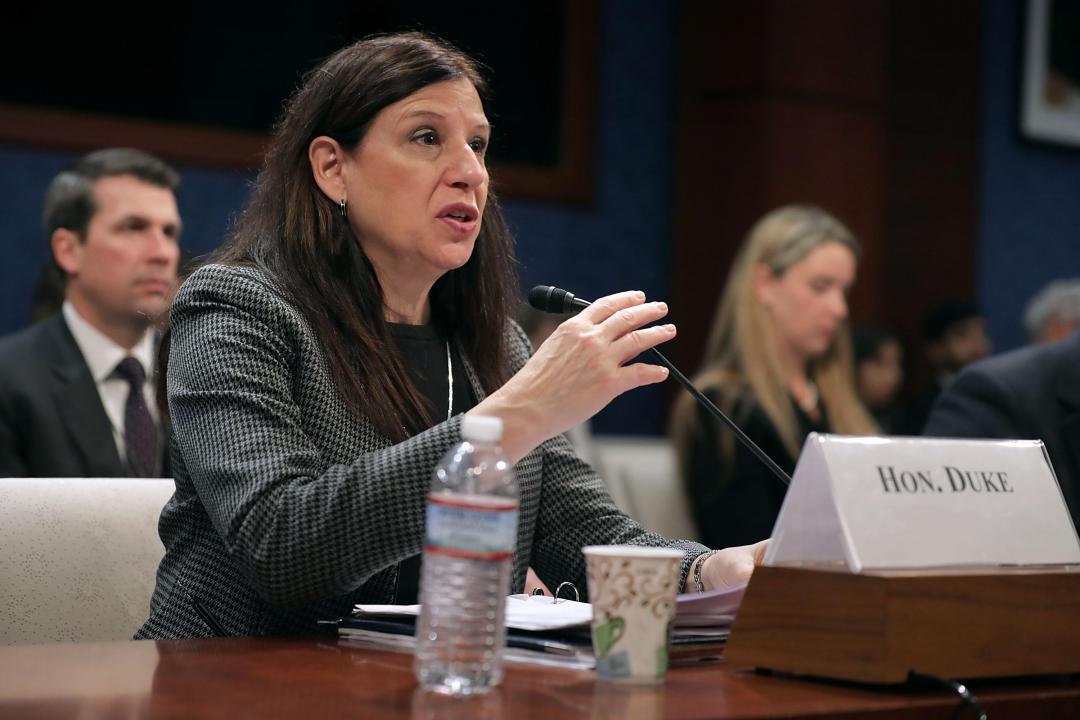
What the DACA? A timeline
The Deferred Action for Childhood Arrivals (DACA) program, enacted by former President Barack Obama, represents a significant stage of evolution within the United States' immigration policy. The undocumented immigrants served by the program embody the ideals that America built itself upon: Those who came here for a better life, free from persecution. These ideals, however, have not protected these individuals from the growing pains of American democracy.
Through in-depth research, Stacker developed a timeline of events that have shaped the enduring debate of where DACA—and the DREAM Act preceding it—fit within the legal definition of "American." Bipartisanship will prove to be the driving mechanism for moving beyond debates about the merits of amnesty, the necessity of deportation for certain populations and the lengths America intends to go in order to secure its borders.
RELATED: What's Happening? A timeline of Mueller's investigation
President Ronald Reagan signs the Immigration Control and Reform Act (IRCA)
Date: November 6, 1986
The IRCA provides amnesty and legal permanent residence to the nearly 2.7 million undocumented people who entered the United States before 1982. The bill is an effort to eliminate the illegal immigration spurred by the Bracero Program and aims to penalize employers that knowingly hire undocumented workers.
Senators Dick Durbin (D-Ill.) and Orrin Hatch (R-UT) co-sponsor legislation called the Development Relief and Education for Alien Minors Act (DREAM)
Date: August 1, 2001
By the turn of the century, the United States holds roughly 11 million undocumented people within its borders. The Dream Act focuses on undocumented children in the country, and aims to provide them with a path to citizenship. The proposal is the first of many failed attempts to establish immigration reform.
President Barack Obama announces the DACA memorandum
Date: June 15, 2012
After a decade of unsuccessful attempts by Congress to pass the DREAM Act, President Obama established the Deferred Action for Childhood Arrivals Program (DACA). The program targets about 800,000 young adults and grants Secretary of Homeland Security Janet Napolitano prosecutorial discretion. The measure pressures Congress to pass bipartisan immigration reform, though critics view Obama’s efforts as an unconstitutional abuse of executive power.
“Gang of Eight” Senators introduce a broad sweeping immigration bill
Date: January 28, 2013
Senators Marco Rubio (R-Fla) and Chuck Schumer (D-NY) lead a bipartisan group to enact immigration reform for undocumented individuals. The group is comprised of constituents familiar with the failures to pass similar bills in 2006, 2007 and 2010.
The “Gang of Eight” Bill passes in the Senate
Date: June 27, 2013
The bill passes with a historic 68–32 decision. Republicans in opposition cite that the reform wrongly relies on amnesty provisions, and cannot ensure that border enforcement measures are met.
The “Gang of Eight” Bill dies in the House of Representatives
Date: June 30, 2014
House Republicans thwarted the promising immigration bill, adding to years of stagnation. One year after the bill is passed in the Senate, the GOP continues to push back against amnesty for the 11 million undocumented individuals already living in the United States.
President Obama announces the DAPA Program
Date: November 20, 2014
The Deferred Action for Unauthorized Immigrant Parents (DAPA) program authorizes the ability to work and removes the risk of deportation for the 3.6 million undocumented parents of young U.S. citizens or legal permanent residents. The combined expansion of DACA extends policy reform to affect five million people. Secretary of Homeland Security Jeh Johnson officially issues the memorandum.
A Federal District Court in Texas files an injunction against the Obama Administration
Date: February 16, 2015
The November 2014 memorandum ties up in the courts due to 25 state attorneys general, led by Texas, who sue the executive branch for exercising power beyond its jurisdiction. DAPA and the expanded DACA policies come to a halt, as immigration policy reform continues to be a politically driven issue.
Trump issues 10-point immigration plan
Date: August 31, 2016
Republican presidential candidate Donald Trump places immigration policy at the forefront of his campaign. Trump's immigration plan suggests the elimination of the Obama administration’s DACA and DAPA memorandums.
Kansas Secretary of State Kris Kobach joins President Trump’s immigration transition team
Date: November 10, 2016
Known for his tough stance on immigration practices, Kris Kobach’s appointment as immigration advisor sets the tone for the Trump’s administration's immigration policy reform.
The Trump Organization begins formally rescinding DACA
Date: September 4, 2017
Attorney General Jeff Sessions submits a letter to Acting Secretary of Homeland Security Elaine Duke concerning rescinding the process of DACA. Sessions claims the policy is unconstitutional, with “the same legal and constitutional defects that the courts recognized in DAPA.”
Acting Secretary Elaine Duke concurs with Attorney General Jeff Sessions
Date: September 5, 2017
Elaine Duke issued a memorandum rescinding the June 15, 2012 memo that established DACA, and set forward a plan for phasing the program out over the next six months. The deadline set for DACA renewals to end was March 5, 2018.
California District Judge orders Trump administration to resume DACA renewals
Date: January 9, 2018
Judge William Alsup of San Francisco deems the Trump administration's phase-out plan to be overly expedient and flawed in approach. The ruling is concurrent with negotiations for a spending bill to begin on Capitol Hill.
President Trump disparages bipartisan approach to protect immigrants from certain countries
Date: January 11, 2018
President Trump issued unfavorable remarks concerning asylum-seekers from countries like El Salvador and Haiti. The comments illuminate the unlikelihood of establishing bipartisan ends to the immigration debate, and isolate activists within the pro-immigrant movement.
Trump administration issues statement intending to fight Supreme Court decision
Date: January 16, 2018
With bipartisan negotiations quickly souring, President Trump’s team requests to bypass the appellate court decision to maintain DACA provisions, and place the rescinding of the program on the Supreme Court docket.
President Trump refuses a bipartisan proposal
Date: January 18, 2018
Bipartisan talks reach another standstill, as Republicans refuse to budge on the creation of the southern border wall and Democrats push for the fortification of the DACA program. Republicans add the Children’s Health Insurance Program (CHIP) as a leverage tool against Democrats unwilling to make compromises on their immigration stances.
The Federal Government reaches a shutdown
Date: January 19, 2018
The House approves a spending bill that isolates DACA recipients, but the Senate falters in following suit. The government effectively shuts down with a GOP majority and DACA as the linchpin in division amongst constituents.
The Federal Government reopens
After a weekend of government shutdown, the Democrats in the Senate move to a compromise that stalls their DACA platform in favor of keeping the process of negotiations alive. Senate Minority Whip Dick Durbin (D-Ill) is hopeful that the restart will bear fruitful ends for the DACA issue, although some Democrats feel that renewing talks makes the party look weak on immigration.
U.S. District Judge blocks President Trump’s DACA agenda for the second time
Date: February 13, 2018
Brooklyn District Judge Nicholas Garaufis rules that the Trump administration maintains the right to move forward with rescinding the DACA initiative; however, flaws in the argument force the judge to rule against the president. All the while, the Trump administration awaits the ability to circumvent the ruling and bring its case before the Supreme Court.
Supreme Court refuses the Trump Administration’s DACA appeal
Date: February 26, 2018
The Supreme Court’s decision ensures that the Trump Administration continues to deal with litigation in the lower courts, while DACA recipients receive hope that they may renew their benefits beyond the initial March 5, 2018 deadline.
The deadline set in Attorney General Jeff Sessions September memorandum comes and goes
Date: March 5, 2018
DACA recipients breathe a sigh of relief as the deadline for renewing program benefits passed without any elimination of benefits, providing normalcy for the pro-immigrant movement despite the disarray.
President Trump’s tweet signals end of White House DACA negotiations
Date: April 1, 2018
President Trump tweets his frustration over the DACA debate. Democrats rebuff on securing his border wall in negotiations.
U.S. District Court Judge John Bates overrules Trump Administration stance on ending DACA
Date: April 24, 2018
Judge John Bates added to the winding narrative of President Trump's setbacks in the lower courts over the shallow nature of his administration's request for a shutdown of DACA.
Secretary of Homeland Security Kirstjen M. Nielsen doubles down on phasing out DACA
Date: June 23, 2018
Secretary of Homeland Security Kirstjen M. Nielsen concurred with the Sept. 5, 2017 memorandum issued by Acting Secretary Elaine Duke, and provided further reasoning for a DACA phase-out in her own memorandum. Secretary Nielsen was simultaneously under fire from multiple protest groups for her stance on President Trump’s family separation policy.
Center for Immigration Studies sues USCIS for DACA information
Date: July 17, 2018
The right-leaning think tank Center for Immigration Studies requests that information regarding criminal history and other personal data for DACA recipients to be made public.



